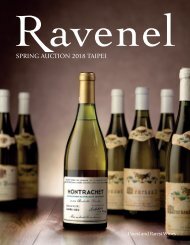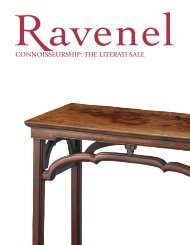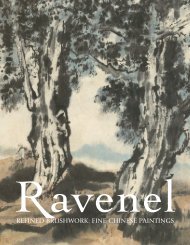亞洲現代與當代藝術 Modern and Contemporary Asian Art
羅芙奧2018春季拍賣會 亞洲現代與當代藝術 Ravenel Spring Auction 2018 Modern and Contemporary Asian Art
羅芙奧2018春季拍賣會 亞洲現代與當代藝術 Ravenel Spring Auction 2018 Modern and Contemporary Asian Art
You also want an ePaper? Increase the reach of your titles
YUMPU automatically turns print PDFs into web optimized ePapers that Google loves.
“Although the influence of Paris is undeniable in all my training as an artist, I also<br />
wish to say that I have gradually rediscovered China as my deeper personality has affirmed<br />
itself. In my recent paintings, this is expressed in an innate manner. Paradoxically,<br />
perhaps, it is to Paris I owe this return to my deepest origins.” - Zao Wou-Ki<br />
REMINISCING EASTERN SENTIMENTS<br />
The year 1971 marked a low point in Zao Wou-Ki’s creative career.<br />
His second wife, Chan May-Kan, was severely ill, <strong>and</strong> Zao just could<br />
not find the heart to create. His friend, Henri Michaux, a poet <strong>and</strong><br />
an artist, suggested that he compose less-dem<strong>and</strong>ing Chinese<br />
ink paintings, <strong>and</strong> Zao re-embraced the profundity of Eastern<br />
conventional painting. May-Kan passed away the following year,<br />
leaving Zao in an abyss of loneliness <strong>and</strong> remorse, unable to pick<br />
up his brush to paint for almost a year <strong>and</strong> a half. In 1972, Zao’s<br />
thoughts were directed to China. It was his first return to his home<br />
country since his departure in 1948. There, he began employing<br />
Chinese media to interpret perspective techniques in western<br />
painting. He imitated the flow, blooming, <strong>and</strong> dripping that ink<br />
creates on cloth or paper, <strong>and</strong> the ink colors he used were varied—<br />
burnt, thick, heavy, light, or clear. He created the effect of form<br />
contained in the formless. The profound thoughts of Eastern culture<br />
touched him <strong>and</strong> inspired him, <strong>and</strong> this era became a turning point<br />
in Zao’s artistic, creative life. The change in this period also enriched<br />
Zao’s creations. In Chinese ink, he saw unlimited variations, a free<br />
<strong>and</strong> wide space, <strong>and</strong> the profound yet reserved concepts of Eastern<br />
philosophy. All of these in Zao’s paintings started in this period<br />
became freer <strong>and</strong> more at ease, exp<strong>and</strong>ing the emotions Zao<br />
wanted to express in the picture.<br />
Gao Xingjian once commented on Zao, “He sought forms, but he<br />
did not fall for formalism. He was particular about color, <strong>and</strong> what<br />
the symphony of colors expressed was an artistic conception.”<br />
Since the Song dynasty, traditional Chinese painting ab<strong>and</strong>oned<br />
the use of color. By contrast, since the Renaissance period, western<br />
paintings have utilized color <strong>and</strong> light, in ways to which Eastern<br />
paintings do not compare. Zao’s abstract oil paints integrated the<br />
characteristics of Chinese ink. He mostly used color to express the<br />
artistic conceptions of oriental philosophy, <strong>and</strong> he integrated the<br />
subtle charm of Chinese ink into oil painting.<br />
A SYMPHONY WITH GORGEOUS COLORS<br />
In 1973, Zao met his third wife, Françoise Marquet, a newlyqualified<br />
intern at a museum in Paris. Afterwards, splendid colors<br />
that had rarely been present in the past started to appear in<br />
his works. The gorgeous color tone spoke volumes about Zao’s<br />
mindset. That same year, Zao created the work 09.07.73. The colors<br />
are simple, light, <strong>and</strong> elegant, exhibiting tenderness beneath the<br />
strength. The bold yet intricate blooming techniques reveal that<br />
the painting was composed in a flow. The picture presents a sense<br />
of movement, <strong>and</strong> the special construction is distant <strong>and</strong> implicit,<br />
reflecting that Zao attempted to integrate a western setting with<br />
the eastern, distant, spatial sense. It can be observed from this<br />
piece that Zao gradually ceased to seek strong <strong>and</strong> magnificent<br />
brush strokes, as if being able to consume the mountains <strong>and</strong><br />
the rivers. He gradually outgrew lines; instead, he utilized the<br />
flow, sway, staggering, <strong>and</strong> stacking of colors to demonstrate a<br />
harmonious picture <strong>and</strong> spatial movement. As if he understood the<br />
circle of life, he used his brushes to express his realization about<br />
living life to the fullest.<br />
Taiwanese painter <strong>and</strong> writer Chu Ko once commented on the<br />
distinctive colors of Zao Wou-ki: "Each of his works has a principal<br />
shade <strong>and</strong> the principal shade of each piece is never a primary<br />
color. Instead, similar colors are set off by contrast in different<br />
arrangements. Though the works are oil paintings, they are smeared<br />
with rich <strong>and</strong> interesting colors. Oil paints are tempered to form<br />
the neutral tone of watercolors – a feat which western artists find<br />
difficult to achieve. The implication of the colors reflects the three<br />
popular notions of Oriental watercolor philosophy; nevertheless,the<br />
rich tones cannot be attained by real watercolors". (Chu Ko, 'Truth of<br />
Nature', Album of Zao Wou-ki, edited by Yuan Dexing, catalogue of Prinkmaker Gallery<br />
exhibition, Yuancheng Publishing Co., Taipei, 1980)<br />
Zao’s creations not only embody the essence behind Chinese <strong>and</strong><br />
western cultures, but he also developed a spirit about the universe<br />
through his infusion of Eastern philosophy. The sceneries he painted<br />
underwent repeated thinking <strong>and</strong> patient precipitation before being<br />
transformed into paintings that reflect his profound experience <strong>and</strong><br />
reflections on his attitude about life. Unlike in the past, when Zao<br />
avoided being restricted by Chinese traditional culture, Zao instead<br />
refamiliarized himself with Chinese ink in 1971, <strong>and</strong> this painting<br />
style gradually granted him a means of interpretation that was<br />
stable, easy, <strong>and</strong> undisturbed. This masterpiece created by Zao in<br />
the 1970s retains the usual flickering lines, but they are no longer<br />
mottled, rugged, or heavy, as in the past. This work integrated<br />
Chinese ink painting. The blank he left is wider, <strong>and</strong> the sky <strong>and</strong> the<br />
clouds reveal an implicit texture, foretelling the coming of his style<br />
of his next era.<br />
142







